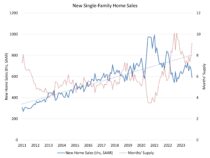Elevated mortgage rates acted as a drag on new home sales in November, but with the economy now apparently past peak interest rates for this cycle, sales are expected to rise as we move into the new year.
Sales of newly built, single-family homes in November fell 12.2% to a 590,000 seasonally adjusted annual rate, according to newly released data by the U.S. Department of Housing and Urban Development and the U.S. Census Bureau. The pace of new home sales in November was the lowest annual rate since November 2022 but sales are up 3.9% on a year-to-date basis due to a lack of resale inventory.

New home sales were weaker in November as mortgage interest rates likely reached a cycle peak at a 7.79% per Freddie Mac at the end of October. Mortgage rates have since moved lower, with Freddie Mac reporting a 30-year fixed-rate of 6.67% this past week. This is consistent with the NAHB/Wells Fargo increasing in December, with builders indicating they expect a rise in future sales. Sales volume for new construction will improve in the months ahead.
A new home sale occurs when a sales contract is signed or a deposit is accepted. The home can be in any stage of construction: not yet started, under construction or completed. In addition to adjusting for seasonal effects, the November reading of 590,000 units is the number of homes that would sell if this pace continued for the next 12 months.

New single-family home inventory in November jumped to the highest level since November 2022, rising 16.5% from the previous month to 451,000. This represents a 9.2 months’ supply at the current building pace. A measure near a 6 months’ supply is considered balanced. However, the market currently requires a higher level of new construction inventory due to a persistent lack of resale inventory. Newly built homes accounted for 31% of total homes available for sale in November, compared to an approximate 12% historical average.
The median new home sale price in November was $434,700, up 4.8% from October, and down 5.9% compared to a year ago.
Regionally, on a year-to-date basis, new home sales are up in all four regions: up 4.9% in the Northeast, 3.6% in the Midwest and 4.4% in the South and 2.6% in the West.
Discover more from Eye On Housing
Subscribe to get the latest posts to your email.


Has anyone recalculated what a balanced inventory level means for new homes given the shortage in existing homes? Also, once lower mortgage rates free up more inventory for existing homes, I wonder what effect, if any, it will have on new home sales…
As a follow up to Dr. Duru’s question, it is likely that the “balanced inventory” for new homes will change each time there is a major interest rate drop. According to sources on Bloomberg News 90% of home owners with a mortgage have an interest rate below 6%, 80% have a mortgage below 5%, and 60% of mortgages are below 4%. About 2/3rds of homeowners have mortgages. Thus, the “balanced inventory” levels will likely be different if rates drop into the 5-6% range, versus if they dropped into the 4-5% range (which we may never see again). In other words, if only 10-20% of existing mortgage owners can benefit (or stay the same) from new 5% rates, then that will continue to lock a lot of home owners into their existing homes. Should be very good for new home demand.
The dip in new home sales during November might seem concerning at first glance, but there’s a silver lining to this data. Despite the temporary setback, the forecast for future improvement indicates a positive trajectory for the housing market. Various factors like supply chain disruptions and fluctuating market conditions might have contributed to this decline. However, with increased stability in supply chains and potential adjustments in market strategies, there’s an optimistic outlook for a rebound in the coming months. This downward trend could signal a momentary pause rather than a long-term slump, especially considering the persistent demand for housing and potential economic recovery. Keeping an eye on the evolving market dynamics and potential shifts in consumer behavior will be crucial, but the prospects for a bounce-back in new home sales appear promising as we move forward.